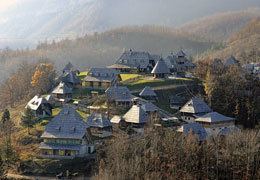ISO 3166 code RS-16 Settlements 438 | Municipalities 9 and 1 city Area 6,140 km² | |
 | ||
Region Šumadija and Western Serbia Points of interest Drina, Mileševa monastery, Tornik, Stopića Cave, Muzej na otvorenom „Staro selo“ Destinations Zlatibor, Tara, Divčibare, Užice, Bajina Bašta | ||
The Zlatibor District (Serbian: Златиборски округ / Zlatiborski okrug, [zlǎtibɔːrskiː ôkruːɡ]) is one of eight administrative districts of Šumadija and Western Serbia. It is located in the western, mountainous part of Serbia. The district was named after the mountain region of Zlatibor. According to the 2011 census results, the Zlatibor District has a population of 286,549 people. The administrative center of the Zlatibor district is Užice.
Contents
- Map of Zlatibor District Serbia
- Municipalities
- Demographics
- Culture
- Tourism
- Education
- Economy and industry
- References
Map of Zlatibor District, Serbia
Municipalities
The district encompasses the municipalities of:
Demographics
According to the last official census done in 2011, the Zlatibor District has 286,549 inhabitants. 51.2% of the population lives in the urban areas. Ethnic composition of the district:
Culture
In the vicinity of Bajina Bašta stands the Rača monastery, built in the 13th century. Over its long history, this monastery was destroyed several times and then reconstructed. Rača Monastery's final destruction (after the Turks and the Austro-Hungarian Army), came at the hands of the Bulgarian army in 1943. It was renovated and restored after the end of World War II. The church was an important center of transcription and illumination of Serbia's manuscripts, with its famed monks known as the Račani, during the 17th century.
The Mileševa Monastery, built in 1234 near Prijepolje, was the endowment of King Stefan Vladislav I of Serbia, the son of Stefan the First-Crowned. This monastery was the second most important in Serbia, after it received the bones of Serbia's most-revered partriarch, Saint Sava, in 1236. The monastery has been destroyed and rebuilt several times, though 100 compositions, frescoes of individual figures, and fragments of important religious icons have been preserved. The most famous icon of Mileševa is The White Angel fresco, a famous, widely used religious icon throughout Serbia.
Tourism
The Zlatibor District is home to several popular tourist destinations. Visitors can seek refuge on the slopes of Zlatibor Mountain, explore the natural beauty of Tara National Park, float down the Drina River or cruise the vast expanse of Lake Perućac, ride the unique rail experience known as Šargan Eight, visit the traditional ethnic village of Mokra Gora, tour the massive World War II monument of Kadinjača Memorial Complex, immerse themselves in the history of Užice and its importance as an independent stronghold throughout its many centuries of life, visit Kremna, home of the world famous Prophecy from Kremna, and stop at various other points of interest in between these destinations.
Education
There is one faculty located in the Zlatibor District that is within the University of Kragujevac:
Economy and industry
The most prominent active economic organizations in the municipality of Užice are the copper and aluminum mill in Sevojno, the "Prvi partizan" metal combine, the "Froteks" textile industry, and "Kadinjača" garment industry.
In Priboj the FAP factory produces trucks and buses, which are then exported throughout the world, and the combined companies FAP-FAMOS produces passenger cars.
